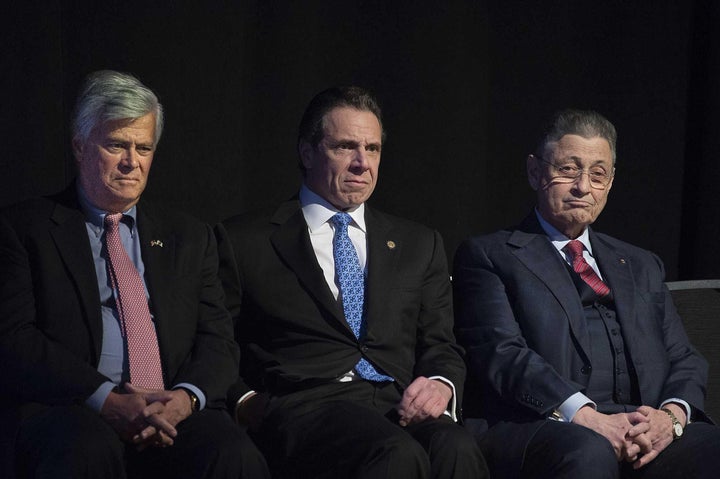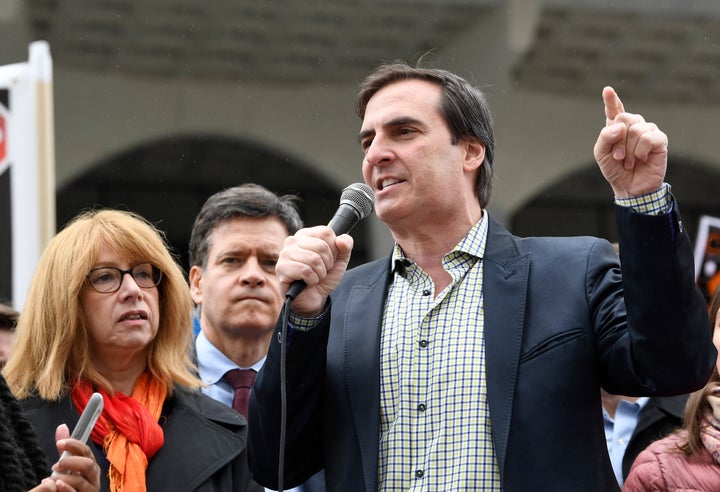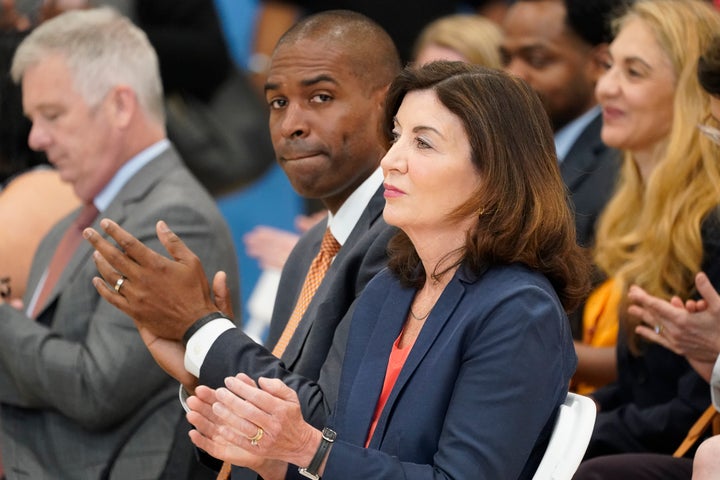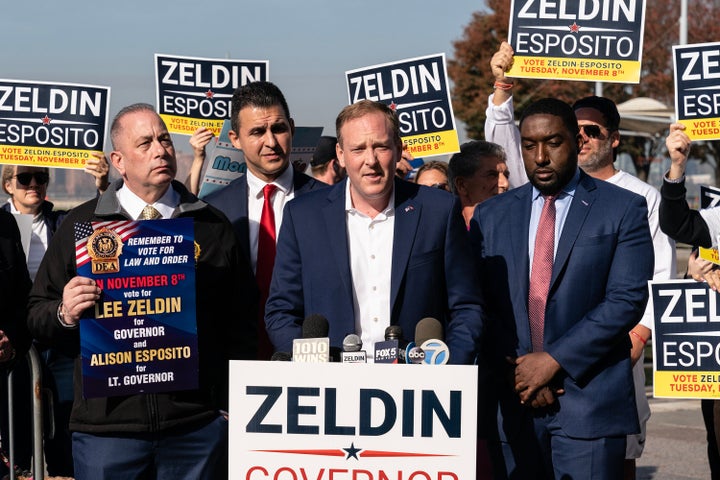It took over a week, but Republicans clinched the majority in the U.S. House of Representatives by a razor-thin margin on Wednesday. While votes are still being counted in some tight races, the GOP is likely to retake power in the lower chamber by between one and four seats.
Democrats’ narrow miss on keeping control of the House has increased scrutiny on the party’s weak showing in New York. Republicans took control of four U.S. House seats in New York previously held by Democrats: two in the Hudson Valley and two on Long Island. Democrats also fell short in a central New York district that President Joe Biden carried and a retiring moderate Republican was vacating.
There are always numerous reasons for a given political outcome, but two critical factors stand out about the Democrats’ overall failure in New York. New York Democrats drafted a congressional redistricting plan that a court struck down on the grounds that it violated a 2014 constitutional amendment barring partisan gerrymandering. And Democratic New York Gov. Kathy Hochul got trounced by her Republican challenger, Rep. Lee Zeldin, in the New York City suburbs, creating a drag on candidates further down on the ballot.
Taken together, it is not an exaggeration to say that the House might remain in Democratic hands if it were not for the party’s disappointing results in New York.
New York’s Redistricting Mess
The roots of New York’s redistricting fiasco date to 2010, when former New York City Mayor Ed Koch, a Democrat, joined good government groups in calling for the state to eliminate partisan gerrymandering. Koch got 138 New York state lawmakers to sign a pledge promising to have an independent body draw new congressional and state legislative districts after the next Census.
Despite this pledge, gerrymandering proceeded apace in 2012. Democrats, who controlled the New York State Assembly, drew legislative districts to their advantage, and Republicans, who controlled the state Senate, drew boundaries that were favorable to themselves. Meanwhile, a federal court imposed new congressional lines.
After initially saying he would veto partisan plans, then-New York Gov. Andrew Cuomo (D) reversed course and bargained instead for a bipartisan compromise that would reform the next decade’s redistricting. He convinced Senate Republicans and Assembly Democrats to pass a constitutional amendment barring partisan gerrymandering.

Under the proposal, an independent commission staffed equally by Democratic and Republican appointees would draw new legislative and congressional lines. If the commission deadlocked, however, the state legislature would have the power to draw new districts itself.
State Senate Democrats, who already felt marginalized by Cuomo due to his collaboration with a group of breakaway Democrats, argued at the time that the plan would be unworkable because of the absence of a tie-breaking vote on the bipartisan, rather than nonpartisan, commission.
In New York, constitutional amendments must first pass the legislature and then be approved by voters at the ballot box. With the support of Cuomo and its adoption in both legislative chambers, voters looked past the objections of figures like state Senate Deputy Democratic Leader Michael Gianaris. In a 2014 referendum, 57% of New York voters voted in favor of adopting the amendment.
Sure enough, the scenario that Gianaris and his colleagues had warned about came to pass. The commission’s five Democrats and five Republicans could not reach an agreement, so they sent dueling maps to the legislature, where Democrats promptly drafted their own maps weighted to give their party an advantage.
“We were very much intentionally designed to fail,” said David Imamura, an attorney and the Democratic chair of the commission, who recently resigned to run for the Westchester County legislature. “I do blame [Cuomo] for accepting a system that was doomed to fail.”
Asked about the even number of commission members, Rich Azzopardi, a former senior aide and spokesperson for Cuomo, said that Cuomo struck what he felt was the best deal he could get from state Senate Republicans and Assembly Democrats at the time.
“Everyone thought there was going to be some good faith in there,” he said.
“We knew this was going to be challenged in court. They absolutely should have seen this coming from a mile away.”
- Zach Fisch, former chief of staff, Rep. Mondaire Jones (D-N.Y.)
Initially, the deadlocked commission seemed like a blessing for Democrats hoping to even out Republican gerrymandering in states like Ohio, Florida and Texas. The map drawn by Democrats in the legislature ― led by Gianaris, who chaired the legislature’s redistricting team ― gave Democrats an advantage in 22 out of New York’s 26 U.S. House seats. If Democrats won all 22, they would pick up three more seats from their total at the time. The net gain over Republicans would be equivalent to four seats, since the seat that New York lost due to population decline would have otherwise leaned Republican.
Given the existing constitutional framework though, some critics worried that Gianaris and his team overplayed their hands.
They questioned the wisdom of drawing two districts in particular. Legislature Democrats decided to draw a congressional district comprising parts of the North Shore of Long Island, Queens, and parts of the Bronx and Westchester County on opposite sides of the Long Island Sound. A second district that included the entirety of Staten Island came to encompass far more liberal Brooklyn neighborhoods such as Park Slope.
Both of those districts may have made it more likely that the New York State Court of Appeals, which has a Democratic majority, would eventually conclude that the map was drawn with the intent of benefiting the Democratic Party.
“If you spoke to people in those communities, they were quite confused,” said Zach Fisch, an attorney and former chief of staff to Rep. Mondaire Jones (D-N.Y.). “It didn’t pass the smell test.”
Fisch had a stake in the maps holding up in court. Community members in Jones’ district in the lower Hudson Valley had worked hard to convince the independent redistricting commission that towns on either side of the Hudson River formed a shared community of interest. Democrats in the legislature drew a district honoring that perspective and insulating Jones from having to run against another Democrat. But once that map was struck down in court, Jones was left having to play musical chairs. He ended up falling short in a Democratic primary after moving to a new, open district in lower Manhattan and Brooklyn.
“At the beginning of this process, we knew what we were working with. We knew this was going to be challenged in court,” Fisch said. “They absolutely should have seen this coming from a mile away.”
The new court-ordered map drafted by a nonpartisan political scientist at Carnegie Mellon University rejected those two districts and contained far fewer Democratic-leaning seats.
Gianaris defended the process, arguing that the appeals court violated the constitution by refusing to give the legislature a chance to draw new maps that met its standard.
“We had a rogue court led by a judge that has since resigned under a cloud of suspicion that issued a completely unconstitutional decision in New York,” he told HuffPost, referring to Chief Judge Janet DiFiore’s resignation from the Court of Appeals in July.

Gianaris called the criticism “Monday morning quarterbacking,” and added, “These are the same people who would have been criticizing us if the maps were not sufficiently favorable [to Democrats], had we done them differently.”
When HuffPost asked Sen. Kirsten Gillibrand (D-N.Y.) about New York Democrats’ lackluster performance, she likewise accused the state’s Court of Appeals of issuing an unconstitutional decision.
Some of the House losses were due to “the challenge of new lines that were so absurd,” she said earlier this week. “I hope someone does litigate them because I think they are unconstitutional.”
But Michael Li, senior counsel at the liberal Brennan Center, faults Democrats in the legislature for failing to take advantage of a window of opportunity to remedy the maps themselves that a judge provided in late March. “By refusing to redraw the map themselves or offer reasonable alternatives, Democrats left the door open to a more radical reworking of the map,” Li wrote on the think tank’s blog.
Gianaris wasn’t the only Democrat to elicit scrutiny. As chair of the Democratic Congressional Campaign Committee, Rep. Sean Patrick Maloney (D-N.Y.) encouraged New York Democrats to draw an even more aggressive map.
While Gianaris maintains that he had no contact with Maloney about redistricting, some blame Maloney for weighing in as a representative of the national Democratic Party, thus making it more likely that state legislature Democrats would overreach.
“Maloney and Gianaris played this far too cute and overreached,” said a New York Democratic insider who requested anonymity to protect professional relationships. “That was the original sin of this year.”
The DCCC did not respond to this criticism.
In a private call with supporters last Thursday, Maloney blamed Hochul for failing to petition the U.S. Supreme Court to hear a challenge to the New York Court of Appeals ruling. During the period when the U.S. Supreme Court assessed the petition, the court would have issued a stay keeping the legislature’s maps in place at least through Election Day, Maloney said.
In an exchange with HuffPost, a spokesperson for Hochul declined to address that claim.
Ultimately, there is no question that the court-ordered congressional district map was less favorable for Democrats than either the Democratic redistricting commission members’ or the state legislature’s proposals. But there is some question as to how much of a difference the earlier maps would have made in what turned out to be a difficult cycle for Empire State Democrats.
The news outlet City & State conducted an analysis suggesting that the two older, more Democratic maps might have spared Democrats some seats upstate, but would not have saved Democrats in the two Long Island House seats they lost by significant margins.
“There was a red wave,” said a Democratic consultant who advised several New York House candidates and requested anonymity for professional reasons. “It was just on Long Island.”

Hochul On The Hustings
Since Election Day, few Democrats have been the target of as much intra-party criticism as Gov. Hochul.
Hochul won her race over Zeldin by nearly six percentage points. But that margin is not much to brag about in a state that President Joe Biden carried by more than 23 points.
Many Democrats believe that Zeldin’s spirited campaign ― and Hochul’s struggle to overcome it ― hurt Democratic candidates for U.S. Congress and the state legislature, especially in the New York City suburbs.
“Even if she had won by more than 10, there would probably be a few more seats that we would have won,” said the Democratic consultant.
In the private call with supporters, Maloney complained that Hochul’s sluggish numbers in his district were impossible to overcome.
“We could have played through the map, as enacted, if the governor had not lost by 10 to 20 points in the suburban counties,” Maloney said. “That’s brutal.”
Indeed, Maloney outperformed Hochul in Rockland and Putnam counties, the entirety of which are in his district. Hochul lost Putnam by just under 21 percentage points and Rockland by 12 points, compared with Maloney’s defeat margins of about 18 percentage points and under 10 points in Putnam and Rockland, respectively.
In both counties, more than twice as many voters left the congressional race blank than left the governor’s race blank, suggesting that some voters showed up specifically to vote for Zeldin and had neutral views of the congressional contest.
Hochul’s team attributes this performance to Zeldin’s effective fearmongering about crime in New York City, amplified by Manhattan-based reactionary news outlets Fox News and the New York Post.
He also got a critical boost from over $11 million in super PAC spending that Republican billionaire Ronald Lauder funded. That money meant that in the final week of the campaign, Zeldin and his allied groups were able to jointly broadcast more TV ads than Hochul and her allies in five of the state’s largest media markets, according to data provided by Hochul’s campaign.
“After just over a year in office, Governor Hochul earned more than three million votes thanks to her work criss-crossing the state and building a broad coalition of elected officials, organized labor, faith leaders, and progressive groups who worked tirelessly to energize voters and elect Democrats up and down the ticket,” Jerrel Harvey, communications director for the Hochul campaign, said in a statement.

But Democrats have complained publicly that Hochul and Lieutenant Gov. Antonio Delgado were not present on the ground enough. These critics also argue that Hochul and the New York State Democratic Committee ― the party’s main convening arm in the Empire State ― lacked a robust field operation.
“Simply put, the Governor’s campaign was completely absent. No public visit to Rockland County from the Gov. or LG,” New York state Sen. Elijah Reichlin-Melnick (D), who lost his re-election bid, said in a Twitter thread lambasting Hochul. “No high profile surrogates in the county. No organizers on the ground. No field team knocking doors.”
New York state Sen. Andrew Gounardes, a Brooklyn Democrat who won reelection, told The City that Democrats’ statewide coordinated campaign had a more organized strategy and field operation in 2018 than it had this cycle.
“Where the hell was the state party?” he asked the day after the election. “We were literally left to die on a vine here. And it’s deeply frustrating that our party didn’t even put up a fight.”
Hochul’s team said she appeared at more than 70 in-person events across the state after Labor Day. The campaign’s total field budget was about $6 million, of which $3.1 million went solely toward a paid canvassing program.
Hochul’s Democratic detractors nonetheless feel that she was slow to fight back against Zeldin’s focus on crime. Zeldin blamed the 2019 law limiting cash bail for an uptick in crime. While Hochul approved a second revision to the law this year that she said would give judges greater discretion to detain criminal defendants awaiting trial, Zeldin promised to repeal the law altogether and take other dramatic steps that he said would curtail crime, such as firing the progressive district attorney of Manhattan.
“The governor’s campaign had the infrastructure and statewide support to deliver a clear message that resonated with voters on key issues like protecting our rights, public safety and democracy.”
- Jerrel Harvey, communications director, Hochul campaign
These critics also note that Hochul’s gaffes gave right-wing media outlets material to exploit that more disciplined candidates might have avoided. The day before the election, Hochul told reporters that Zeldin “has been hyperventilating” about crime, which the New York Post treated as evidence that she is dismissive of ordinary New Yorkers’ legitimate concerns.
In internal congressional campaign polls, Hochul rated worse than the generic Democratic Party ballot among likely voters, in addition to trailing the congressional candidates, according to the Democratic consultant who advised multiple New York congressional candidates.
“When you’re running for executive office ― governor or mayor ― you’re present in people’s lives in a way that they expect things that relate to their day-to-day,” the consultant said. “I don’t think there was ever a rationale articulated by Kathy Hochul in terms of why Kathy Hochul wants to be governor. I don’t know what she wants to do in the next four years.”
“Zeldin had a real premise he was running on, that whether real or exaggerated, people felt was really relevant to their lives,” the consultant added.
Hochul’s campaign maintains that it did have a positive message, noting that eight of the 15 TV ads she ran during the primary and the general election were strictly positive in tone.
“The governor’s campaign had the infrastructure and statewide support to deliver a clear message that resonated with voters on key issues like protecting our rights, public safety and democracy,” Harvey said. “New Yorkers met the moment, turned out, and elected Governor Hochul to a full term and she looks forward to four more years of delivering results to families across the state.”
Hochul’s campaign said that nine out of its 15 TV ads address the issue of public safety.
But most of those ads focus on Hochul’s efforts to enact tougher gun regulations. Of the 12 TV ads that Hochul aired in the general election ― from early September through Election Day ― HuffPost could find just three ads that provide a traditional case for Hochul’s credentials as a crime fighter.
The first is a Spanish-language ad in early September featuring a retired police detective touting Hochul’s commitment to combatting crime.
Then, in late October, as polls showed Zeldin within striking distance, Hochul released a TV spot in which a narrator promises that Hochul is fighting to provide a “safe walk home at night, a subway ride free of fear.” The ad cites Hochul’s passage of legislation to beef up public safety, including by revising the 2019 bail law.
Hochul speaks to the camera for the conclusion of the spot. “You deserve to feel safe,” she says. “And as your governor, I won’t stop working until you do.”
A final TV ad contrasts Hochul’s record on gun control with Zeldin’s, again touts her work revising the bail law, and concludes with the same promise that Hochul “won’t stop working” until New Yorkers “feel safe.”
Some Democrats believe she should have used stronger language.
For example, Pennsylvania Attorney General Josh Shapiro (D), who won his race for governor of Pennsylvania by a much larger margin than Hochul won hers, promised to fight for residents to “be safe,” as well as “feel safe,” which he used to mean feel safe around law enforcement.

What’s more, none of Hochul’s general-election TV ads feature Delgado, who is Black and represented the Hudson Valley in Congress.
“I don’t know if anybody knew that Antonio Delgado was running,” said one prominent New York Democrat, who requested anonymity to preserve a relationship with Hochul.
Meanwhile, Zeldin assembled a racially diverse group of New York Democrats to explain on camera why crime had pushed them to vote for him.
In another TV ad, Zeldin vowed that he would not and “could not” act to restrict abortion rights in New York. New York state Assembly Speaker Carl Heastie (D), a Hochul supporter, confirmed in a Twitter thread that any attempts to pass anti-abortion legislation would go nowhere, but also noted that Zeldin could use his power over the budget process to restrict the practice.
“Zeldin controlled the narrative, controlled the pace of the race, and just sunk [every Democratic candidate] who wasn’t in areas with a lot of Democratic voters,” said a second Democratic strategist who advised a New York congressional candidate and requested anonymity for professional reasons.
Hochul now faces pressure to at least fire Jay Jacobs, a longtime Cuomo ally who chairs the New York State Democratic Committee.
“We did very well,” Hochul said while speaking to reporters on Nov. 10, two days after the election. “He did a great job as chair and will continue to be chair.”
But progressive Democrats, in particular, are likely to continue to push for Jacobs’ ouster.
After Jacobs declined to endorse Democratic nominee India Walton’s bid for mayor of Buffalo in 2021, he rankled the left by likening his decision not to back her after her primary win to the dilemma he would face if former Ku Klux Klan leader David Duke won a Democratic primary. (Walton, who went on to lose a write-in campaign to Mayor Byron Brown, is a Black woman.)
“It’s more than just the fact that he is far to the right of rank-and-file New York Democrats, he failed to properly support Kathy Hochul’s campaign and he is directly tied to the Cuomo status quo that resulted in disastrous congressional maps that will likely cost the Democratic House majority,” said Bill Neidhardt, a prominent progressive consultant whose clients include the New York Working Families Party. “Jay Jacobs has so fundamentally dropped the ball in New York that he has cost national Democrats a majority.”
Igor Bobic contributed reporting.

